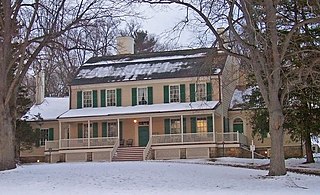
The John Jay Homestead State Historic Site is located at 400 Jay Street in Katonah, New York. The site preserves the 1787 home of Founding Father and statesman John Jay (1745–1829), one of the three authors of The Federalist Papers and the first Chief Justice of the United States. The property was designated a National Historic Landmark in 1981 for its association with Jay. The house is open year-round for tours.
The George T. Wisner House, also known as Oak Hill, is a historic home located on South Street in Goshen, New York, United States. It was built about 1840, and is a Greek Revival style frame dwelling that incorporates an earlier Federal style dwelling built about 1805. It has a broad gabled roof and a central hall plan interior. The front section is 2+1⁄2 stories, five bays wide and four bays deep.

The Richard Nichols House is a historic late First Period house at 483 Franklin Street in Reading, Massachusetts, United States. It is a 2+1⁄2-story wood-frame structure, six bays wide, with a side-gable roof, clapboard siding, rubblestone foundation, and an entry in the third bay from the left, with a chimney behind. The oldest portion of this house, probably a three-bay section with chimney, was built c. 1733, and expanded to five, and then six, bays later in the 18th century. The house, along with extensive landholdings, remained in the locally prominent Nichols family until the late 19th century.
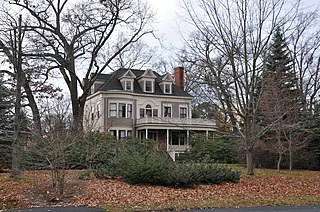
The House at 22 Parker Road is one of a few high style Colonial Revival houses in Wakefield, Massachusetts. The 2+1⁄2-story wood-frame house is estimated to have been built in the 1880s. It has a hip roof, corner pilasters, and gable end dormers, the center one having a swan-neck design. The main facade is divided into three sections: the leftmost has a rounded bay with three windows on each level, and the right section has a Palladian window configuration on the first floor, and a pair of windows on the second. The central section has the front door, sheltered by a porch that wraps around to the right side, flanked by sidelights and topped by a fanlight. Above the front door is a porch door flanked by wide windows and topped by a half-round window with Gothic style insets.

The Bevier-Wright House is a historic house located at 776 Chenango Street in Port Dickinson, Broome County, New York.

The J. Ball House is a historic house located at Berkshire in Tioga County, New York.

US Post Office-Cooperstown is a historic post office building located at Cooperstown in Otsego County, New York, United States. It was built in 1935-1936, and is one of a number of post offices in New York State designed by the Office of the Supervising Architect of the Treasury Department, Louis A. Simon. It is one story in front and two stories in the rear with and exposed basement. It is constructed of brick on a raised concrete foundation and limestone watercourse and beltcourse. The principal facade is symmetrically composed with a three bay pedimented central section faced entirely with ashlar limestone. The building displays Colonial Revival style details. The interior features a 1938 sculpture by artist Bela Janowsky depicting James Fenimore Cooper and two characters from his writings, Chingachgook and Natty Bumpo.

Wayside Cottage is a historic home located at Scarsdale, Westchester County, New York. The earliest part of the house was built about 1720 and is the four-bay-wide, two-bay-deep, 1+1⁄2-story south section. It sits on a fieldstone foundation and has a gable roof and verandah with Doric order piers. The center section of the house was built in 1828 and it is a 2+1⁄2-story, three-bay-wide structure with a gable roof and sheathed in clapboard. A third section is known as the "caretaker's quarters" and was built in the late 19th century. It is two stories high, three bays wide, and two bays deep. A wing was added to this section in 1928. The house underwent a major restoration in 1953–1954. Since 1919, it has been owned by the Junior League of Central Westchester. It was also where Scarsdale Public Library used to be.

Public Bath House No. 3, also known as Yonkers Avenue Pool, is a historic public bath located on the border of the Getty Square and Nodine Hill neighborhoods in Southwest Yonkers, Westchester County, New York. It was built in 1909 and is a two-story, five bay wide red brick building with lively tile ornamentation in the Second Renaissance Revival style. It features a hipped tile parapet at the roofline that hides the flat roof. The interior is in three sections: reception area, custodian's apartment, and a pool and showers. It was remodeled in 1930 and 1958. It has been used for swimming classes.
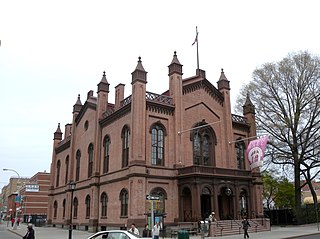
Flushing Town Hall is a historic Town Hall located on Northern Boulevard at Linden Place in the Flushing section of the New York City borough of Queens. Formerly, it served as the seat of government of the village of Flushing, established as Vlissingen in 1645, until the consolidation with New York City in 1898. It was built in 1862 and is a 2-story, three-by-six-bay, brick building with basement and attic. A style of architecture that originated in Germany, Rundbogenstil, was used here and in a number of American buildings of the Civil War Era. The earliest photographs show the building to have been painted a light color. The use of paint was discontinued following adhesion problems during a restoration. A small rear wing was added in 1938 containing a block of jail cells. The front facade features a triple arched portico topped by a classic entablature with low balustrade.
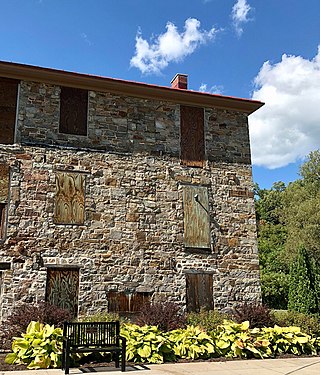
Heyworth–Mason Industrial Building is a historic factory located in Peru, Clinton County, New York. It was built in 1836, and is a three-story, seven-bay, rectangular, sandstone building measuring 35 feet wide and 60 feet long. It has a gable roof and interior end chimneys. It originally housed a factory and later storage. It was converted to apartments in the 1970s.
Terpenning–Johnson House and Cemetery is a historic home and family cemetery located at Brooker Hollow, Schoharie County, New York, United States. The main block was built about 1845, and is a two-story, five-bay, dwelling with a 1+1⁄2-story side wing built about 1810. Both sections have gable roofs rest on a stone foundation. Also on the property are the contributing family cemetery with burials dated from 1812 to 1873, garage, workshop, and barn (1840s).

Maxbilt Theatre is a historic theater located at Fleischmanns, Delaware County, New York. It was built in 1929, and is a two-story, brick, concrete block, and stucco building. It measures 65 feet wide and 185 feet deep, and consists of three sections: a five-bay by three-bay main block,, a large auditorium, and a one-story, rectangular concrete block rear section. It is an intact example of a small regional theater built during the heyday of the Catskills resort era.

Bartlett House, a historic railroad hotel, restored in 2016 to house a kitchen, bakery, and cafe. It was built about 1870, and is a three-story, five bay by five bay, square, Italianate style brick building on a raised basement. It features a full width front porch at the primary story and decorative cornice. The name BARTLETT HOUSE appears in white lettering between the second and third stories.
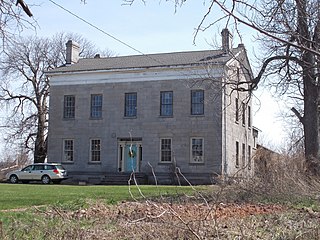
Pound–Hitchins House, also known as “Mount Providence” and Ruhlmann House, is a historic home located at Lockport, Niagara County, New York. It was built about 1833 and is a two-story, five-bay, Greek Revival style dwelling with a large two-story wing. It has a side-gable roof and end chimneys, and is constructed of large-block ashlar Gasport limestone. It features an elaborate central entry with an original six-panel wood door recessed slightly behind two engaged Ionic order columns in antis with sidelights and panels.
Barna C. Roup House is a historic home located at Perry in Wyoming County, New York. It was built in 1898, and is a 2+1⁄2-story, Queen Anne-style frame dwelling with a 1927 addition. It features intersecting gable roofs, asymmetrical massing, polygonal bays on three sides, and an elaborately detailed, wrap-around porch. The porch is supported by Doric order columns and has a turreted roof and a small balcony above. Also located on the property is a two-bay, wood-frame pyramidal hipped-roof garage dated to the early 19th century. The house was built by a notable local attorney during the period of village's major growth.

Endicott-Johnson Medical Clinic, also known as the Wilson Hospital Annex, is a historic hospital building located at Binghamton, Broome County, New York. It was built in 1928 by the Endicott Johnson Corporation as a part of its "Square Deal" program. It is a two-story, T-shaped steel frame building with a flat roof, clad in red brick. It has a projecting central section that is four bays wide and a one-story enclosed portico. It was sold in 1946 to the Wilson Memorial Hospital and used as an annex. In 1967, it was purchased by New York State for use as a day care center for the Binghamton Psychiatric Center.

Denniston–Steidle House also known as Pineview Farm and the Steidle Farm is a historic home located at New Windsor in Orange County, New York. It was built about 1875, with a rear ell added in 1915. It consists of a two-story, three-bay, Italianate style main block with a 1+1⁄2-story rear ell. The farmhouse is a rare example of non-reinforced lime-based concrete construction in the region; the ell is of terra cotta block construction. Also on the property are the contributing timber frame banked carriage house, terra cotta block wellhouse, and a frame outhouse.
Jacob H. Patten House is a historic home located in the former village of Lansingburgh at Troy, Rensselaer County, New York. It was built in 1881–1882, and is a two-story, two-bay-wide by three-bay-deep, Italianate style brick dwelling. It sits on a brick and stone foundation and a pitched roof hidden by a low parapet. The front facade features a one-story, shallow, hipped roof porch with square, chamfered columns and brackets. Also on the property is a contributing two-story carriage house.

Christamore House is a historic settlement house associated with Butler University and located at Indianapolis, Marion County, Indiana. It was built between 1924 and 1926, and is 2+1⁄2-story, U-shaped, Georgian Revival style brick mansion. It consists of a two-story, five-bay, central section flanked by one-story wings. It has a slate hipped roof and is nine bays wide, with a three-bay central pavilion. The building features large round-arched windows and contains an auditorium and a gymnasium.




















